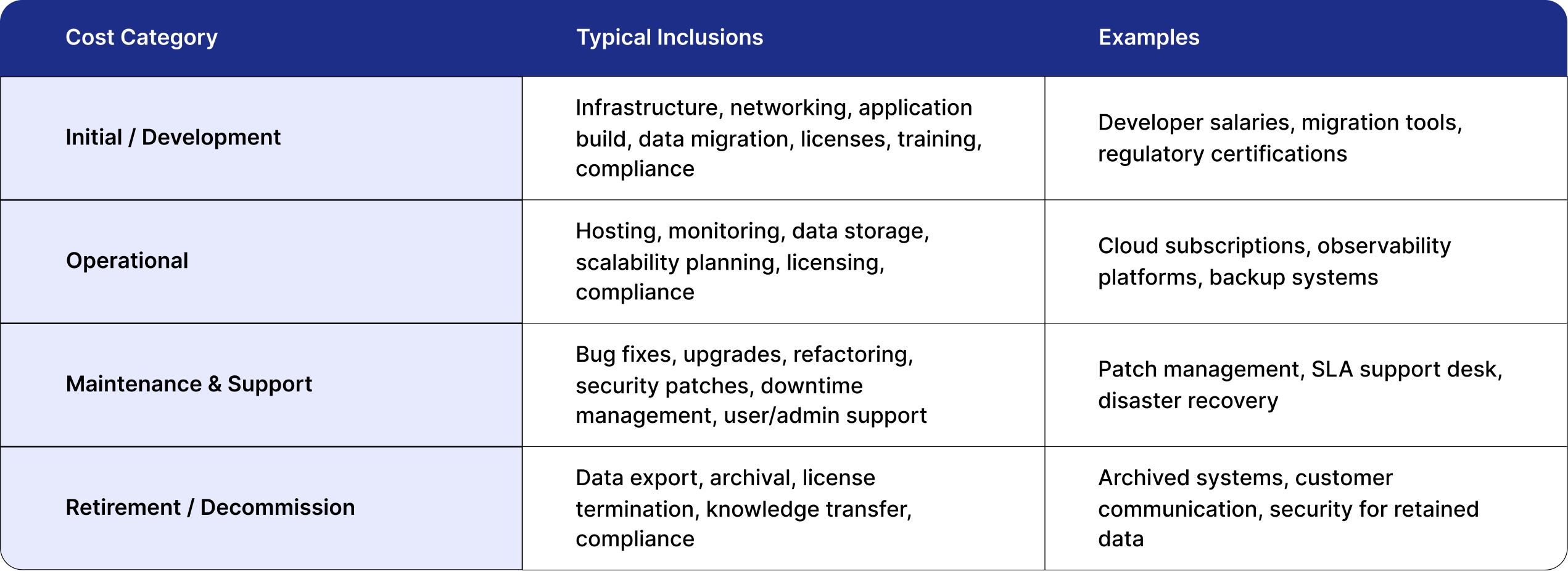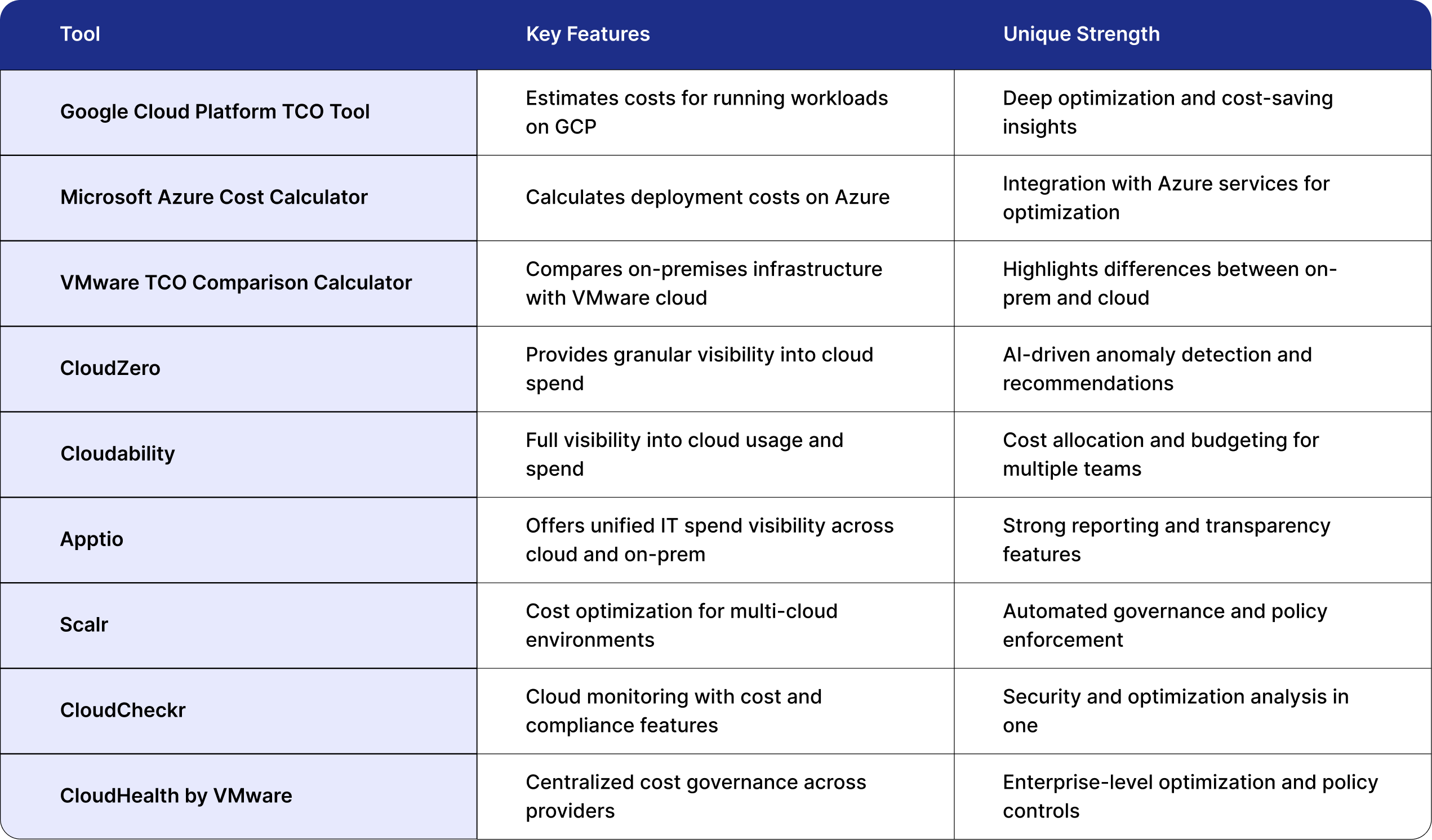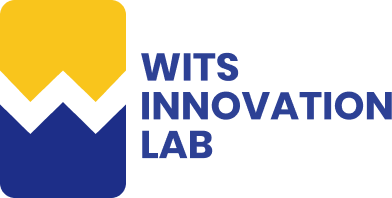Published - 3 months ago | 6 min read
The CTO’s Guide to Understanding the Total Cost of Ownership (TCO) for Digital Products
When a boardroom looks at a new digital initiative, the first question is usually about ROI. But return on investment can only be measured correctly if the full cost of ownership is known. That is where the total cost of ownership, or TCO, becomes critical.
For CTOs, TCO is not an accounting formality. It is a decision-making tool that influences technology strategy, budgeting discipline, and even the company’s long-term valuation. Understanding and controlling TCO means less time spent firefighting and more time driving innovation.
This guide walks through the cost components of TCO, explains methods of calculation, outlines the tools that help, and shows why mastering TCO is an essential part of a CTO’s legacy.
For CTOs, TCO is not an accounting formality. It is a decision-making tool that influences technology strategy, budgeting discipline, and even the company’s long-term valuation. Understanding and controlling TCO means less time spent firefighting and more time driving innovation.
This guide walks through the cost components of TCO, explains methods of calculation, outlines the tools that help, and shows why mastering TCO is an essential part of a CTO’s legacy.
Why TCO is Different from ROI
ROI and TCO are often discussed in the same breath, but they answer different questions. ROI is a measure of financial return relative to the investment made. It tends to be short-term, focused on revenue, profit margins, or cost savings visible within a defined period. ROI is what executives and investors look at when deciding if a project is “worth it.”
TCO, on the other hand, is concerned with the full lifecycle of a product. It tracks every cost that goes into acquiring, running, maintaining, and eventually retiring a system. This long-term view captures expenses that ROI models often ignore, such as integration, compliance audits, downtime, or decommissioning.
For a complete picture, both must be calculated together. ROI without TCO risks overestimating value by ignoring hidden costs. TCO without ROI risks undervaluing opportunities by ignoring the revenue side of the equation. A CTO who can present these numbers side by side provides the most reliable foundation for executive decision-making.
TCO, on the other hand, is concerned with the full lifecycle of a product. It tracks every cost that goes into acquiring, running, maintaining, and eventually retiring a system. This long-term view captures expenses that ROI models often ignore, such as integration, compliance audits, downtime, or decommissioning.
For a complete picture, both must be calculated together. ROI without TCO risks overestimating value by ignoring hidden costs. TCO without ROI risks undervaluing opportunities by ignoring the revenue side of the equation. A CTO who can present these numbers side by side provides the most reliable foundation for executive decision-making.

What TCO Means in Practice
TCO represents the complete set of expenses related to a digital product over its entire lifecycle. That lifecycle begins with development and implementation, continues through operations and maintenance, and ends with retirement or decommissioning.
For a product, TCO includes infrastructure, licensing, staffing, support, security, compliance, upgrades, migrations, and end-of-life costs. When these are mapped accurately, a CTO can present a realistic picture of financial exposure and identify opportunities for optimization.
For a product, TCO includes infrastructure, licensing, staffing, support, security, compliance, upgrades, migrations, and end-of-life costs. When these are mapped accurately, a CTO can present a realistic picture of financial exposure and identify opportunities for optimization.
Why CTOs Need to Pay Attention to TCO
Technology leaders carry the responsibility of ensuring that investments create business value. Without a proper understanding of TCO, a product can quickly become a liability instead of an asset.
By monitoring TCO, CTOs are able to:
- Control budgets with fewer unexpected costs.
- Provide boards and investors with clear financial predictability.
- Align technical decisions with growth targets.
- Support ESG initiatives by factoring in energy usage and carbon impact.
- Balance innovation with stability, ensuring capacity to scale without eroding margins.
In short, TCO transforms technology choices into business choices.
By monitoring TCO, CTOs are able to:
- Control budgets with fewer unexpected costs.
- Provide boards and investors with clear financial predictability.
- Align technical decisions with growth targets.
- Support ESG initiatives by factoring in energy usage and carbon impact.
- Balance innovation with stability, ensuring capacity to scale without eroding margins.
In short, TCO transforms technology choices into business choices.
Breaking Down the Costs that Make Up TCO
TCO is made up of several categories. Each requires detailed attention, as gaps in one area often show up later as financial or operational pain. Below is a structured view of the main cost categories every CTO should evaluate:

If not planned, retirement costs can create business disruption. Treated correctly, they can also be an opportunity to modernize and streamline operations.
How to Calculate TCO
A structured approach makes TCO manageable. CTOs can follow a phased methodology:
1. Step 1: Define Scope Precisely
Start by clarifying both business requirements and technical needs. This includes data models, APIs, concurrency rules, and dependency updates. Scope creep is one of the largest hidden drivers of increased TCO.
Step 2: Select Infrastructure and Technology with Care
Choose platforms and tools based on scalability, security, cost-effectiveness, and compliance. Factor in vendor lock-in risks and global regulatory differences. Align selections with financial governance practices such as cost allocation and FinOps reporting.
Step 3: Plan for Development and Maintenance
Account for dependencies, change management, and testing. Include costs for technical documentation and training, which often determine whether adoption is successful or not.
Step 4: Include Security and Compliance from the Start
Budget for access control, encryption, audits, certifications, and monitoring. Architectural decisions—such as data separation or identity management—will influence security costs across the lifecycle.
Step 5: Monitor and Optimize Continuously
Track resource usage, cloud spend, and system performance in real time. Maintain Architecture Decision Records to ensure that technical choices align with business strategy. Regular optimization prevents small inefficiencies from compounding into large overruns.
Tools That Simplify TCO Analysis
Given the number of factors, manual tracking is error-prone. A range of tools exists to provide clarity:

The best choice depends on the environment, but all of them reduce guesswork and support transparent reporting.
TCO as a Strategic Responsibility
TCO is not just a budgeting exercise. It is a measure of how technology leadership balances innovation with fiscal responsibility. Boards and investors look for predictability, and a disciplined approach to TCO provides that assurance.
For a CTO, managing TCO well means:
- Technology decisions are financially transparent.
- Scaling does not come at the cost of uncontrolled spending.
- Systems remain secure and compliant across their lifecycle.
- Retirement is planned in advance rather than forced by crisis.
Handled properly, TCO becomes part of the CTO’s strategic legacy. It shows that technology is managed as a business enabler rather than an unpredictable expense.
For a CTO, managing TCO well means:
- Technology decisions are financially transparent.
- Scaling does not come at the cost of uncontrolled spending.
- Systems remain secure and compliant across their lifecycle.
- Retirement is planned in advance rather than forced by crisis.
Handled properly, TCO becomes part of the CTO’s strategic legacy. It shows that technology is managed as a business enabler rather than an unpredictable expense.

TCO Reduction Strategies
A mature TCO practice is not just about measuring costs but actively reducing them. Strategies can be applied at three levels:
Architecture-level
- Design modular systems that allow incremental upgrades.
- Use APIs to ensure interoperability and reduce integration rework.
- Avoid monolithic architectures that drive up maintenance and refactoring costs.
- Use APIs to ensure interoperability and reduce integration rework.
- Avoid monolithic architectures that drive up maintenance and refactoring costs.
Process-level
- Automate repetitive tasks with CI/CD pipelines and infrastructure as code.
- Adopt DevSecOps practices to integrate security early and reduce costly fixes later.
- Continuously monitor performance to detect inefficiencies before they escalate.
- Adopt DevSecOps practices to integrate security early and reduce costly fixes later.
- Continuously monitor performance to detect inefficiencies before they escalate.
Governance-level
- Negotiate aggressively with vendors to avoid long-term lock-in and inflated license fees.
- Implement strict license management to prevent overspending on unused seats.
- Apply cloud rightsizing and reserved instance planning to align capacity with real demand.
- Implement strict license management to prevent overspending on unused seats.
- Apply cloud rightsizing and reserved instance planning to align capacity with real demand.
These levers work together. Well-structured architecture lowers operational friction, streamlined processes reduce human overhead, and strong governance ensures financial discipline.
How TCO Shapes Strategic Decisions
TCO analysis is not just a budgeting exercise. It has a direct influence on major business decisions:
- Mergers and acquisitions: During due diligence, acquiring companies scrutinize TCO to understand how much technical debt they are inheriting. An inflated TCO can lower valuation or even block a deal.
- Fundraising: Investors want confidence that the company’s cost structure is sustainable. Demonstrating control over TCO can build credibility and strengthen the case for funding.
- Product pivots: High TCO can limit agility. If the cost of maintaining the current platform is too high, it becomes harder to allocate resources toward innovation or new features. Lowering TCO creates room for experimentation and growth.
By embedding TCO into these strategic decisions, a CTO ensures that technology choices are directly linked to the company’s financial resilience and competitive positioning.
- Mergers and acquisitions: During due diligence, acquiring companies scrutinize TCO to understand how much technical debt they are inheriting. An inflated TCO can lower valuation or even block a deal.
- Fundraising: Investors want confidence that the company’s cost structure is sustainable. Demonstrating control over TCO can build credibility and strengthen the case for funding.
- Product pivots: High TCO can limit agility. If the cost of maintaining the current platform is too high, it becomes harder to allocate resources toward innovation or new features. Lowering TCO creates room for experimentation and growth.
By embedding TCO into these strategic decisions, a CTO ensures that technology choices are directly linked to the company’s financial resilience and competitive positioning.
Conclusion
Total cost of ownership is the foundation for making technology investments responsibly. By accounting for initial development, operations, maintenance, and retirement, leaders avoid hidden surprises and position
their organizations for sustainable growth. The goal is not only to control cost but to maximize value.
Organizations that treat TCO as a continuous discipline build stronger ROI, maintain healthier systems, and create long-term resilience. For a CTO, this is one of the clearest signals of leadership:
financial stewardship that supports technical excellence.

Written by / Author
Manasi Maheshwari
Found this useful? Share With
Top blogs
Most Read Blogs
Wits Innovation Lab is where creativity and innovation flourish. We provide the tools you need to come up with innovative solutions for today's businesses, big or small.
© 2025 Wits Innovation Lab, All rights reserved
Crafted in-house by WIL’s talented minds

